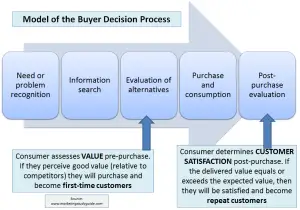Customer Satisfaction (CSat) and Customer Value are Different Concepts in Marketing
Customer satisfaction and value are both fundamental concepts in the understanding of marketing. It is important to note that while they are highly interrelated, they also operate independently.
Essentially, value is when a consumer perceives that they will get a good deal from the company, brand, product or service. To put this in more marketing terms, the consumer will see value when the benefits they expect to receive exceed the expected costs and effort involved in acquiring the product. Please note that customer value is discussed in more detail in another article on this website.
Therefore, as potential customers (that is, the target market) will be attracted to the offering if they perceive that the benefits exceed the cost (which equals value), the ability of a firm to be able to offer good value is paramount to its success in generating ongoing new customers.
This means that value is a pre-purchase assessment of the product by the consumer. If a consumer perceives that the product brand or service offers very little value based on their pre purchase assessment OR if they perceive that it offers less value than a competitive offering, then the consumer will not buy that particular item.
In terms of the buyer decision process (which marketing students will cover in consumer behavior topics), this pre-purchase assessment occurs in the evaluation phase.
Customer satisfaction, on the other hand, occurs after the consumer has become a customer. That means they have purchased the product or have had dealings with a service firm with. Customer satisfaction is their assessment of how well that value was delivered – that is, did they get the value that they expected to receive? (Again, please note that there is a separate section article on this website that discusses customer satisfaction in more detail). In terms of the buyer decision process, this customer satisfaction assessment occurs in the post-purchase phase.
Therefore, the difference between customer satisfaction and value is that one is a pre-purchase assessment and the other is a post purchase assessment; as shown in the following model.

(Click to enlarge)
Implications of the difference between customer satisfaction and value
After the purchase (when the consumer has become a customer), the customer assesses whether or not the value that they expected to receive was actually delivered.
If the consumer is satisfied then they are more likely to repurchase the product or continue their relationship with a service firm.
If they are dissatisfied then they are less likely to become a repeat customer.
The full range of implications is covered in the following table:
Perceived Value Offering (Pre-purchase expectations) | Impact on New Customers | Perceived Value Received (Post-purchase assessment) | Impact on Existing Customers |
High | Due to consumers perceiving a HIGH level of value, a good number of new customers will be generated | High | If HIGH value is also delivered, then customers will be satisfied and will be LIKELY repeat purchasers |
Medium or low | If LESSER value is actually delivered, customers will be dissatisfied and be LESS LIKELY repeat purchasers | ||
Low | Due to consumers perceiving a LOW level of value, new customers will be hard to acquire | Low | Even if LOW value is delivered, as this was expected customers will still be satisfied and be LIKELY repeat purchasers |
Medium or high | If BETTER value is delivered, customers will be very satisfied and be VERY LIKELY to be repeat purchasers |
As you can see from the above table, it then becomes quite important for the firm to:
- Build good value offerings
- Communicate good value offerings
- Deliver good value, and
- Ensure that pre-purchase expectations of value are aligned with the actual value that the product or service can deliver
Related Topics
What is the difference between customer satisfaction and service quality?
